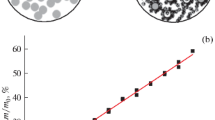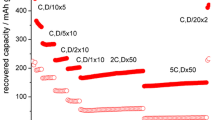Abstract
We present a systematic work to design a void-shell nanostructures for improving the stability of silicon electrodes while alloying with lithium. To enhance the electrical conductivity, silicon is coated with carbon by using a simple and non-hazard route prior to embedding the Si particles in silicon carbonitride (SiCN). An inactive matrix, namely a polymer-derived SiCN ceramic is used to stabilize the composite. Additionally, cavities around silicon to accommodate volume changes are introduced by partial carbon burning. Significant increase in porosity of more than one order of magnitude is found by means of BET measurements for the samples obtained after additional heat treatment in air. TGA coupled with FTIR spectrometry shows that the ceramic matrix is stable upon heating, while burned carbon originates from pyrolyzed fructose. TEM micrographs confirm the presence of carbon/void around silicon particles embedded in the ceramic matrix. Electrochemical investigations reveal an improved conductivity due to the presence of carbon coating. Contribution of silicon in lithium storage is identified, whereas voids introduced around the silicon particles are found to improve cycling stability of silicon.









Similar content being viewed by others
References
Obrovac MN, Christensen L (2004) Structural changes in silicon anodes during lithium insertion/extraction. Electrochem Solid-State Lett 7(5):A93–A96
Li J, Dahn JR (2007) An in situ X-ray diffraction study of the reaction of Li with crystalline Si. J Electrochem Soc 154(3):A156–A161
Wachtler M, Besenhard JO, Winter M (2001) Tin and tin-based intermetallics as new anode materials for lithium-ion cells. J Power Sources 94(2):189–193
Liu XH, Zhong L, Huang S, Mao SX, Zhu T, Huang JY (2012) Size-dependent fracture of silicon nanoparticles during lithiation. ACS Nano 6(2):1522–1531
Saint J, Morcrette M, Larcher D, Laffont L, Beattie S, Peres JP, Talaga D, Couzi M, Tarascon JM (2007) Towards a fundamental understanding of the improved electrochemical performance of silicon carbon composites. Adv Funct Mater 17(11):1765–1774
Liu WR, Wang JH, Wu HC, Shieh DT, Yang MH, Wu NL (2005) Electrochemical characterizations on Si and C-coated Si particle electrodes for lithium-ion batteries. J Eletrochem Soc 152(9):A1719–A1725
Yang XL, Wen ZY, Xu XX, Lin B, Lin ZX (2006) High-performance silicon/carbon/graphite composites as anode materials for lithium ion batteries. J Electrochem Soc 153(7):A1341–A1344
Kim I-S, Kumta PN (2004) High capacity Si/C nanocomposite anodes for Li-ion batteries. J Power Sources 136(1):145–149
Kim IS, Blomgren GE, Kumta PN (2004) Si-SiC nanocomposite anodes synthesized using high-energy mechanical milling. J Power Sources 130:275–280
Dimov N, Kugino S, Yoshio M (2003) Carbon-coated silicon as anode material for lithium ion batteries: advantages and limitations. Electrochim Acta 48(11):1579–1587
Mazouzi D, Lestriez B, Roue L, Guyomard D (2009) Silicon composite electrode with high capacity and long cycle life. Electrochem Solid State Lett 12(11):A215–A218
Martin C, Alias M, Christien F, Crosnier O, Belanger D, Brousse T (2009) Graphite-grafted silicon nanocomposite as a negative electrode for lithium-ion batteries. Adv Mater 21(46):4735–4741
Chen B, Flatt AK, Jian H, Hudson JL, Tour JM (2005) Molecular grafting to silicon surfaces in air using organic triazenes as stable diazonium sources and HF as a constant hydride-passivation source. Chem Mater 17(19):4832–4836
Xu YH, Yin GP, Zuo PJ (2008) Geometric and electronic studies of Li15Si4 for silicon anode. Electrochim Acta 54(2):341–345
Martin C, Crosnier O, Retoux R, Belanger D, Schleich DM, Brousse T (2011) Chemical coupling of carbon nanotubes and silicon nanoparticles for improved negative electrode performance in lithium-ion batteries. Adv Funct Mater 21(18):3524–3530
Yang S, Li G, Zhu Q, Pan Q (2012) Covalent binding of Si nanoparticles to graphene sheets and its influence on lithium storage properties of Si negative electrode. J Mater Chem 22:3420–3425
Chen D, Yi R, Chen S, Xu T, Gordin ML, Wang D (2014) Facile synthesis of graphene-silicon nanocomposites with an advanced binder for high-performance lithium-ion battery anodes. Solid State Ionics 254:65–71
Chan CK, Peng H, Liu G, McIlwrath K, Zhang XF, Huggins RA, Cui Y (2008) High-performance lithium battery anodes using silicon nanowires. Nat Nano 3(1):31–35
Chan CK, Ruffo R, Hong SS, Huggins RA, Cui Y (2009) Structural and electrochemical study of the reaction of lithium with silicon nanowires. J Power Sources 189(1):34–39
Vlad A, Reddy ALM, Ajayan A, Singh N, Gohy J-Fo, Melinte S, Ajayan PM (2012) Roll up nanowire battery from silicon chips. Proc Natl Acad Sci 109(38):15168–15173
Kasavajjula U, Wang C, Appleby AJ (2007) Nano- and bulk-silicon-based insertion anodes for lithium-ion secondary cells. J Power Sources 163(2):1003–1039
Wu H, Zheng G, Liu N, Carney TJ, Yang Y, Cui Y (2012) Engineering empty space between Si nanoparticles for lithium-ion battery anodes. Nano Lett 12(2):904–909
Yue L, Zhang W, Yang J, Zhang L (2014) Designing Si/porous-C composite with buffering voids as high capacity anode for lithium-ion batteries. Electrochim Acta 125:206–217
Zhou X, Tang J, Yang J, Xie J, Lulu M (2013) Silicon@carbon hollow core-shell heterostructures novel anode materials for lithium ion batteries. Electrochim Acta 87:663–668
Li X, Meduri P, Chen X, Qi W, Engelhard MH, Xu W, Ding F, Xiao J, Wang W, Wang C, Zhang J-G, Liu J (2012) Hollow core–shell structured porous Si–C nanocomposites for Li-ion battery anodes. J Mater Chem 22(22):11014–11017
Szczech JR, Jin S (2011) Nanostructured silicon for high capacity lithium battery anodes. Energy Environ Sci 4(1):56–72
Kaspar J, Graczyk-Zajac M, Lauterbach S, Kleebe H-J, Riedel R (2014) Silicon oxycarbide/nano-silicon composite anodes for Li-ion batteries: considerable influence of nano-crystalline vs. nano-amorphous silicon embedment on the electrochemical properties. J Power Sources 269:164–172
Reinold LM, Graczyk-Zajac M, Gao Y, Mera G, Riedel R (2013) Carbon-rich SiCN ceramics as high capacity/high stability anode material for lithium-ion batteries. J Power Sources 236:224–229
Reinold LM, Yamada Y, Graczyk-Zajac M, Munakata H, Kanamura K, Riedel R (2015) The influence of the pyrolysis temperature on the electrochemical behavior of carbon-rich SiCN polymer-derived ceramics as anode materials in lithium-ion batteries. J Power Sources 282:409–415
Baek S-H, Reinold LM, Graczyk-Zajac M, Riedel R, Hammerath F, Buchner B, Grafe H-J (2014) Lithium dynamics in carbon-rich polymer-derived SiCN ceramics probed by nuclear magnetic resonance. J Power Sources 253:342–348
Graczyk-Zajac M, Fasel C, Riedel R (2011) Polymer-derived-SiCN ceramic/graphite composite as anode material with enhanced rate capability for lithium ion batteries. J Power Sources 196(15):6412–6418
Bhandavat R, Singh G (2012) Improved electrochemical capacity of precursor-derived Si(B)CN-carbon nanotube composite as Li-Ion battery anode. ACS Appl Mater Inter 4(10):5092–5097. doi:10.1021/am3015795
Reinold LM, Graczyk-Zajac M, Fasel C, Riedel R (2011) Prevention of solid electrolyte interphase damaging on silicon by using polymer derived SiCN ceramics. ECS Trans 35:37–44
David L, Bhandavat R, Barrera U, Singh G (2015) Polymer-derived ceramic functionalized MoS2 composite paper as a stable lithium-ion battery electrode. Scientific Rep 5(9792):1–7
David L, Bernard S, Gervais C, Miele P, Singh G (2015) Facile synthesis and high rate capability of silicon carbonitride/boron nitride composite with a sheet-like morphology. J Phys Chem C 119(5):2783–2791
David L, Asok D, Singh G (2014) Synthesis and extreme rate capability of SiAlCN functionalized carbon nanotube spray-on coatings as Li-Ion battery electrode. ACS Appl Mater Inter 6(18):16056–16064
Bhandavat R, Singh G (2013) Stable and efficient Li-Ion battery anodes prepared from polymer-derived silicon oxycarbide carbon nanotube shell/core composites. J Phys Chem C 117(23):11899–11905. doi:10.1021/jp310733b
Joho F, Novak P, Spahr ME (2002) Safety aspects of graphite negative electrode materials for lithium-ion batteries. J Electrochem Soc 149(8):A1020–A1024
Mera G, Navrotsky A, Sen S, Kleebe H-J, Riedel R (2013) Polymer-derived SiCN and SiOC ceramics—structure and energetics at the nanoscale. J Mater Chem A 1(12):3826–3836
Sing KSW, Everett DH, Haul RAW, Moscou L, Pierotti RA, Rouquerol J, Siemieniewska T (1985) Reporting physisorption data for gas/solid systems with special reference to the determination of surface area and porosity. Pure Appl Chem 57(4):603–619
de Boer JH, Linsen BG, van der Plas T, Zondervan GJ (1965) Studies on pore systems in catalysts: VII. description of the pore dimensions of carbon blacks by the t method. J Catal 4(6):649–653
Colombo P, Riedel R, Soraru GD, Kleebe H-J (2010) Polymer derived ceramics: from nano-structure to applications. DEStech Publications Inc, Lancaster
Schitco C, Bazarjani MS, Riedel R, Gurlo A (2015) NH3-assisted synthesis of microporous silicon oxycarbonitride ceramics from preceramic polymers: a combined N2 and CO2 adsorption and small angle X-ray scattering study. J Mater Chem A 3:805–818
Park J-K (2012) Principles and applications of lithium secondary batteries. Wiley-VCH Verlag GmbH & Co, KGaA
Graczyk-Zajac M, Wimmer M, Neumann C, Riedel R (2015) Lithium intercalation into SiCN/disordered carbon composite. Part 1: influence of initial carbon porosity on cycling performance/capacitygraczyk2015. J Solid State Electrochem 19:2763–2769
Acknowledgements
We gratefully acknowledge the financial support of the German Research Foundation (DFG) SPP1473/JP8. We thank Christina Schitco for fruitful discussions and attentive manuscript proof reading. Furthermore, we also thank Ulrike Kunz, Claudia Fasel, and Cristina Schitco for their help with material characterization.
Author information
Authors and Affiliations
Corresponding author
Electronic supplementary material
Below is the link to the electronic supplementary material.
Rights and permissions
About this article
Cite this article
Vrankovic, D., Reinold, L.M., Riedel, R. et al. Void-shell silicon/carbon/SiCN nanostructures: toward stable silicon-based electrodes. J Mater Sci 51, 6051–6061 (2016). https://doi.org/10.1007/s10853-016-9911-x
Received:
Accepted:
Published:
Issue Date:
DOI: https://doi.org/10.1007/s10853-016-9911-x




